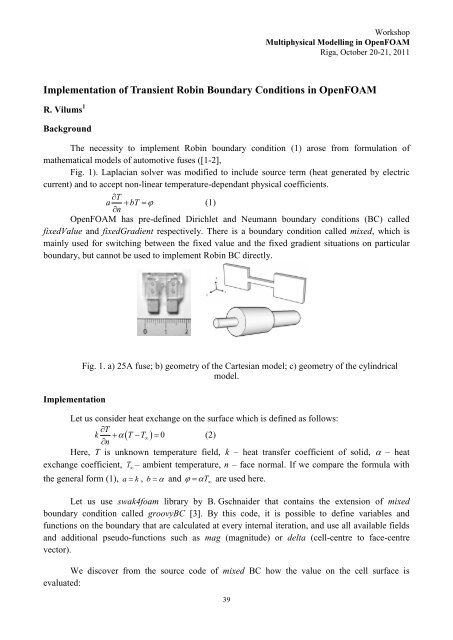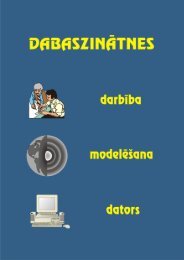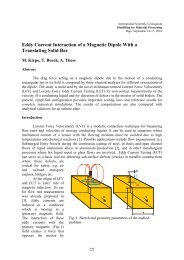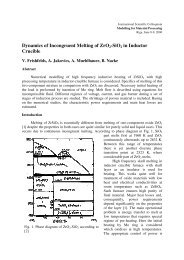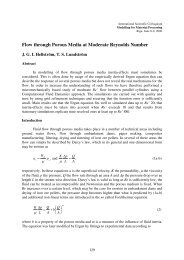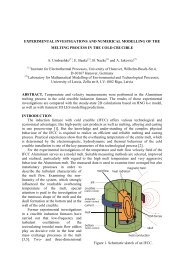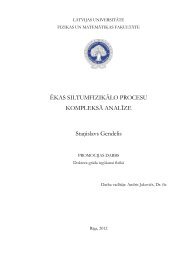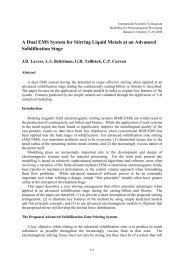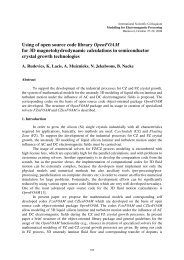Implementation of Transient Robin Boundary Conditions in ...
Implementation of Transient Robin Boundary Conditions in ...
Implementation of Transient Robin Boundary Conditions in ...
Create successful ePaper yourself
Turn your PDF publications into a flip-book with our unique Google optimized e-Paper software.
Workshop<br />
Multiphysical Modell<strong>in</strong>g <strong>in</strong> OpenFOAM<br />
Riga, October 20-21, 2011<br />
<strong>Implementation</strong> <strong>of</strong> <strong>Transient</strong> <strong>Rob<strong>in</strong></strong> <strong>Boundary</strong> <strong>Conditions</strong> <strong>in</strong> OpenFOAM<br />
R. Vilums 1<br />
Background<br />
The necessity to implement <strong>Rob<strong>in</strong></strong> boundary condition (1) arose from formulation <strong>of</strong><br />
mathematical models <strong>of</strong> automotive fuses ([1-2],<br />
Fig. 1). Laplacian solver was modified to <strong>in</strong>clude source term (heat generated by electric<br />
current) and to accept non-l<strong>in</strong>ear temperature-dependant physical coefficients.<br />
T<br />
a<br />
bT <br />
(1)<br />
n<br />
OpenFOAM has pre-def<strong>in</strong>ed Dirichlet and Neumann boundary conditions (BC) called<br />
fixedValue and fixedGradient respectively. There is a boundary condition called mixed, which is<br />
ma<strong>in</strong>ly used for switch<strong>in</strong>g between the fixed value and the fixed gradient situations on particular<br />
boundary, but cannot be used to implement <strong>Rob<strong>in</strong></strong> BC directly.<br />
<strong>Implementation</strong><br />
Fig. 1. a) 25A fuse; b) geometry <strong>of</strong> the Cartesian model; c) geometry <strong>of</strong> the cyl<strong>in</strong>drical<br />
model.<br />
Let us consider heat exchange on the surface which is def<strong>in</strong>ed as follows:<br />
T<br />
k T T 0<br />
n <br />
<br />
(2)<br />
<br />
Here, T is unknown temperature field, k – heat transfer coefficient <strong>of</strong> solid, – heat<br />
exchange coefficient, T <br />
– ambient temperature, n – face normal. If we compare the formula with<br />
the general form (1), a k, b and T are used here.<br />
<br />
Let us use swak4foam library by B. Gschnaider that conta<strong>in</strong>s the extension <strong>of</strong> mixed<br />
boundary condition called groovyBC [3]. By this code, it is possible to def<strong>in</strong>e variables and<br />
functions on the boundary that are calculated at every <strong>in</strong>ternal iteration, and use all available fields<br />
and additional pseudo-functions such as mag (magnitude) or delta (cell-centre to face-centre<br />
vector).<br />
We discover from the source code <strong>of</strong> mixed BC how the value on the cell surface is<br />
evaluated:<br />
39
T f valueExpr f T gradExpr ,<br />
face<br />
(1 ) <br />
centre<br />
where f is fractionExpression def<strong>in</strong>ed by user and – distance between the cell centre and<br />
cell face.<br />
obta<strong>in</strong>:<br />
If we l<strong>in</strong>earise the derivative <strong>in</strong> the formula (2) by<br />
1<br />
T<br />
face<br />
and T<br />
centre<br />
, and isolate T<br />
face<br />
, we<br />
Tface<br />
fT<br />
1 f T<br />
, k <br />
center f 1<br />
. (3)<br />
<br />
Comparison with the previous expression shows how to implement this BC <strong>in</strong> a code.<br />
outerSurface<br />
{<br />
}<br />
type groovyBC;<br />
variables "k=0.2;alpha=15;T<strong>in</strong>f=65; f=1/(1+k/(alpha*mag(delta())));";<br />
valueExpression "T<strong>in</strong>f";<br />
gradientExpression "0";<br />
fractionExpression "f";<br />
value uniform 0;<br />
Constants k, and T <br />
were used here. For the transient parameters, it is recommended to<br />
def<strong>in</strong>e and calculate them <strong>in</strong> a solver as fields or calculate directly <strong>in</strong> groovyBC, e.g.<br />
“k=0.2+0.03*T+4e-5*pow(T,3)”.<br />
Acknowledgement<br />
This work was supported by the ESF Project No. 2009/0223/1DP/1.1.1.2.0/APIA/VIAA/008<br />
References<br />
Vilums, R., Buikis, A. Conservative Averag<strong>in</strong>g and F<strong>in</strong>ite Difference Methods for <strong>Transient</strong> Heat<br />
Conduction <strong>in</strong> 3D Fuse. WSEAS Transactions on Heat and Mass Transfer. 3(1):111-124, 2008.<br />
Vilums, R., Liess, H.-D., Buikis, A., Rudevics A. Cyl<strong>in</strong>drical Model <strong>of</strong> <strong>Transient</strong> Heat Conduction<br />
<strong>in</strong> Automotive Fuse Us<strong>in</strong>g Conservative Averag<strong>in</strong>g Method. The 13 th WSEAS Int. Conf. on Applied and<br />
Computational Mathematics, Puerto De La Cruz, Tenerife, Spa<strong>in</strong>, 355-360, 2008.<br />
Gschaider, B. Swak4Foam [Onl<strong>in</strong>e: http:// openfoamwiki.net/<strong>in</strong>dex.php/Contrib/swak4Foam]<br />
1 University <strong>of</strong> Latvia, Faculty <strong>of</strong> Physics and Mathematics, Zellu iela 8, Riga, LV-1459, Latvia<br />
40


